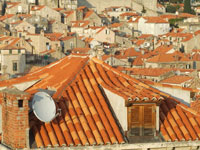 Dubrovnik OverviewDespite a turbulent history during which it has been occupied
and conquered by a succession of its neighbours and European
colonial powers, Dubrovnik is now a town at peace, allowing
visitors to make the most of its historical architecture, white
pebble beaches and crystal-clear sea. Political upheaval has seldom kept tourists away from this
uniquely lovely Adriatic port city; for centuries it has drawn
those seeking fine accommodations, excellent cuisine, beautiful
surroundings and recreational opportunities. George Bernard Shaw is
quoted as describing Dubrovnik as 'heaven on earth'. The old town, dating from the 7th century, is on UNESCO's list
of World Heritage Sites. Enclosed by city walls built in the 13th
century, the buildings represent a cross-section of medieval
architectural styles and remain well preserved. Onofrio's Fountain,
situated just inside the main entrance to the old city at Pile
Gate, is one of Dubrovnik's most famous landmarks and a popular
meeting place. The centre of the old town is the Stradun, its main
street, which was originally a channel separating an island from
the mainland, and was filled in to join two opposite towns into the
merged city of Dubrovnik. There are numerous churches, monasteries
and museums to explore; the old town also boasts plenty of
restaurants, bars and shops; and the coastal belt is awash with
marinas, coves and promenades. Most of the hotels and the best
beaches are located north west of the old town at Lapad, as well as
in Ploce to the north east. |